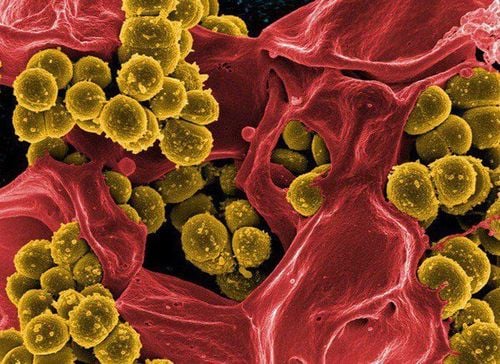This is an automatically translated article.
The article was consulted with Doctor Department of Pediatrics - Neonatology, Vinmec Hai Phong International General Hospital.
A lung abscess is an infection of the lungs. New antibiotics, advances in anesthesia, and dynamic surgical resuscitation have significantly reduced the rate of lung abscesses compared to the past.
1. What is a lung abscess?
Lung abscess is an acute inflammation of the lung parenchyma that causes necrosis, destruction of alveolar membranes, capillaries forming a cavity containing pus.
The pus of the abscess is degenerated leukocytes and necrotic substances. Lung abscesses may have one or more foci. The formation of multiple abscesses can lead to pneumonia or lung necrosis.
Lung abscess is classified into 2 types
Primary lung abscess: A lung abscess caused by bronchial tract Secondary lung abscess: A lung abscess caused by an infection that appeared before outside the lung such as bacterial infection blood, liver abscess growing into the lung, abscess under the diaphragm.
2. Factors that cause lung abscess
The main causative agents of lung abscess are:
Anaerobic bacteria: accounting for more than 60% of common lung abscess cases. Staphylococcus aureus: Common in lung abscesses in children, infants who are still breastfed with symptoms such as high fever, vomiting, abdominal distension, weight loss,... Clinical symptoms are both pulmonary and pleural, causing respiratory failure , severe infections,... Klebsiella Pneumoniae: When bacteria enter the lungs, they grow very quickly, the disease is often severe, and the risk of death is high. Parasites: The most common is amoeba, causing lesions at the bottom of the right lung, close to the diaphragm, dark brown sputum or fresh blood. Lung abscess can occur at any age, but middle age has a higher incidence, the incidence in men is 2.5 times higher than in women. Since the advent of new antibiotics and effective treatment regimens, the incidence of lung abscess has decreased markedly. But until now, lung abscess is still a problem of concern in both medical and surgical practice. The treatment rate of lung abscess ranks fourth in lung diseases.

3. Pathogenesis of lung abscess
Patients with lung abscesses are mainly due to decreased protective mechanisms of the pulmonary airways. Normally, the lower airways are free of bacteria, the local lung defense mechanism will eliminate the bacteria. If this protective mechanism is lost or diminished, a lung abscess will have room to develop. Factors that cause loss or decrease of lung defense mechanisms are alcohol, tobacco, certain drugs, number and toxicity of bacteria entering the respiratory tract, immunocompromised state, malnutrition, etc. occupational diseases.
The majority of lung abscesses are primary, bacteria that cause lung abscesses follow the following routes:
Airway-bronchi: When performing upper respiratory tract surgery such as tonsillectomy, tooth extraction, normal blood easily inhaled into the bronchi carrying disease-causing bacteria. Infectious substances from purulent sinuses can be inhaled into the lungs while sleeping. In addition, when the cough reflex is inhibited, the vomit is inhaled into the bronchi, during emergency gastric bypass surgery with food in the stomach can reflux and cause the above complications. Blood: Due to phlebitis, endocarditis causes embolism, infarction and abscesses. Commonly caused by Staphylococcus aureus, especially often causing lung abscess in children. Adjacent lines: Subdiaphragmatic abscess, bile duct abscess, liver abscess, esophageal abscess, purulent pleurisy, pericarditis,...
4. Is lung abscess dangerous?
4.1 Clinical course of lung abscess The disease usually goes through the following stages:
4.1.1 Stage of closed pustulosis Patient has fever 39-40oC, chest pain, shortness of breath, dry cough or coughing up purulent mucus . If the patient is treated with appropriate antibiotics, the symptoms will be reduced, not turning into the purulent stage. If left untreated or inadequately treated with antibiotics, the disease will progress and the patient will vomit pus.
4.1.2 Stage of pustulosis The patient usually spits out pus from the 5th to the 15th day, but there are also cases where it takes a few weeks to spit out pus. Before vomiting pus, the patient coughs more, may cough up blood first because the pus cavity is broken. After a few strong coughs, the patient had severe chest pain and then vomited a lot of pus, sometimes up to several hundred ml. Patient has difficulty breathing, restlessness, anxiety. During the purulent stage, it is necessary to prevent pus from overflowing into the airways, causing suffocation. After a few hours, the patient is stable, the patient's fever is reduced, he is comfortable, he can eat and sleep. There are cases where the patient coughs up pus discreetly, in these patients the sputum must be monitored.
4.1.3 Stage of purulent foci with bronchi The patient still has a strong, persistent cough, fatigue, and purulent discharge with less amount. The patient was pale, thin, physically exhausted, white blood cell count and polymorphonuclear leukocyte percentage increased.
4.2 Dangerous complications of lung abscess If not treated with antibiotics or ineffective treatment, the patient may experience the following complications:
The patient may have bacteremia, the body may be exhausted gradually, kidney failure, heart failure, then death after a few weeks. Turn to chronic lung abscess with manifestations such as: The patient spits up pus, the general condition of the body improves in a few days or a few weeks. After that, there is a period of pus accumulation, the amount of pus is less, then a new episode of pus, followed by a period of temporary remission. The episodes of the disease follow each other, around the abscess, fibrous organizations form, making the lung abscess difficult to treat, unable to heal on its own. Hemoptysis is severe, many times due to rupture of large blood vessels. Coughing up blood is especially serious when the abscess is near the hilum, the patient can die. Pulmonary necrosis occurs at a rapid rate, especially in immunocompromised patients. Emphysema due to rupture of an abscess into the pleural space. Other dangerous complications that threaten the patient's life such as bronchiectasis, pulmonary fibrosis, brain abscess, pulmonary tuberculosis, ...
5. What to do to prevent lung abscess?

Lung abscess is a serious disease that can lead to life-threatening complications. To prevent the disease, it is necessary to pay attention to good oral hygiene, nose and throat to avoid the risk of infection from above spreading to the lungs. Pay special attention in subjects at high risk of aspiration into the bronchi such as patients with epilepsy, hemiplegia, myasthenia gravis...
Prevention of foreign bodies falling into the airways. Exercise regularly to improve physical strength, supplement the diet with nutritious foods and vitamin-rich foods to increase resistance. When there are signs of respiratory infection such as cough, chest pain, high fever, ... need to go to medical facilities for timely examination.
Please dial HOTLINE for more information or register for an appointment HERE. Download MyVinmec app to make appointments faster and to manage your bookings easily.







